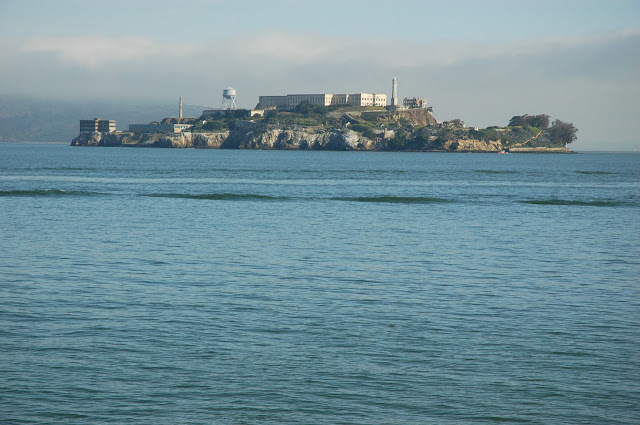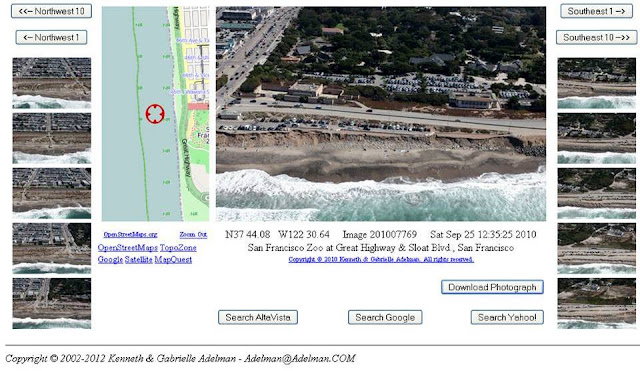We started off the day at the Van Ness Pier at Aquatic Park, where John oriented the group to the geography of San Francisco. As you might expect, the geography of the City has a lot to do with its geologic history. The rocks units, or "terranes", that make up San Francisco are the result of complex plate tectonics, uplift, and erosion processes at the margin of the North American plate some 65 to 175 million years ago. As the ancestral Farallon plate subducted (or plunged) underneath the North American plate, pieces of oceanic crust material were transported to and pasted onto the edge of the continent. Some of these rock units were originally formed thousands of miles away in the tropical ocean while others were formed just offshore, as sediments were eroded from the mountains and deposited in a submarine trench. These rocks and sediments were then buried deep within the earth, heated and compressed, and later brought up to the surface through uplift and erosion of the overlying material, exposing the San Francisco we see today. The photo below shows John talking about the various terranes that comprise San Francisco, with Alcatraz Island in the background.
 |
| John discussing the geology of San Francisco at the Van Ness Pier. |
Speaking of Alcatraz, we learned that Alcatraz Island is primarily comprised of the same thick beds of sandstone and other rock units that form some of the higher hills in the northeast part of the City (such as Telegraph Hill, Russian Hill, and Nob Hill). The photo below shows the steep sandstone cliffs along the shoreline of Alcatraz. Looks like a lovely place to spend a vacation!
 |
| Eroded sandstone cliffs of the Alcatraz terrane, Alcatraz Island. |
 |
| The restored tidal lagoon at Crissy Field. |
After Crissy Field we moved on to a great renovated viewpoint at Battery Godfrey. I had never been here before, believe it or not, and it was quite a site! The overlook had a great view of the Golden Gate Bridge, Kirby Cove (straight across the Bay in Marin), and Marshall Beach below. In the photo below, you can see a great exposure of a serpentine landslide, a rock formed at mid-ocean spreading centers many millions of years ago. Another interesting fact about serpentine rocks is that the heavy metal, low nutrient soil derived from them is toxic to many plants, a characteristic that favors the native slow-growing plants of San Francisco!
 |
| View of the Marin Headlands from Battery Godfrey and serpentine landslide. |
 |
| Battery Godfrey in San Francisco was constructed in the late 1890s and is now part of the GGNRA. |
From Battery Godfrey we headed over to the Seacliff neighborhood and walked down the steps to China Beach. According to the monument at the parking lot, China Beach got its name from the Chinese fisherman who moored their boats in the cove and camped on the beach during the gold rush era. At this stop, we looked at some of the rock exposures that illustrate the extreme complexity of the geologic processes that formed the rocks we see here - sandstone, chert, and pillow basalts all mashed together in one big confusing mess!
 |
| View of the Golden Gate Bridge from China Beach with graywacke sandstone outcrops in the sand. |
Next, we headed out to the Lands End/Sutro Baths area, which is part of the San Bruno Mountain terrane. The rocks here consist mainly of thick sandstone beds that were deposited as part of a submarine fan at the edge of the North American plate around 100 million years ago.
 |
| John pointing out the San Andreas fault across the Gate in Marin County, visible as a depression in the ridgeline. |
In some outcrops, the sandstone beds alternate with beds of shale (finer sediments). These alternating beds can be seen on the trail down to the sea caves, at the north end of the Sutro Baths ruins. The sediment layers likely represent what are referred to as turbidity currents, which are very dense mixtures of sediment and water that flow along the ocean floor. Turbidity currents are one way that sands and muds in the nearshore area are carried down submarine canyons and out to deepwater.
 |
| Alternating beds of sandstone and shale at the Sutro Baths ruins. |
Our final stop was the bluffs at Fort Funston, at the southern end of the San Francisco shoreline. In geologic time, these bluffs are quite young, formed only a few hundred thousand years ago. Much of the bluffs is comprised of the weakly consolidated sands, muds, gravel, and silt of the Merced Formation, which formed in a sandy coastal dune and nearshore environment. Due to their soft nature, these bluffs are easily eroded by wave action and this stretch of coastline exhibits very high erosion rates and incredibly large landslides (such as the Thornton Beach landslide during the 1982-83 El Nino winter). In the photo below, the point in the distance is Mussel Rock, which represents the point where the San Andreas fault runs offshore out into the ocean (it intersects the coastline line again as it runs through Bolinas Lagoon, Tomales Bay, and Bodega Bay farther north). Here, at Fort Funston, we see geologic processes acting on a much faster time scale, with ongoing marine and terrestrial erosion of the bluffs, compounded by the periodic seismic shaking and instability of large earthquakes along the nearby San Andreas fault (such as the 1906 and 1989 quakes).
 |
| The uplifted marine terrace at Fort Funston with the heavily developed Daly City in the background. |
Overall, it was a great trip with a very knowledgeable guide. Thanks to John Karachewski and the Field Institute for a great day by the coast!
Note: The following web resource was also consulted to verify my recollection of the concepts discussed during the field class ((c) Ted Konigsmark): http://www.geologictrips.com/sf/sfttsf.pdf.







